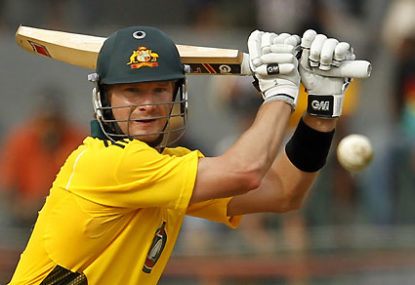James Faulkner’s form slump could see him lose his spot in the Australian side for the upcoming World T20, with Shane Watson’s century yesterday heaping further pressure on him.
Faulkner has been an automatic selection in Australian limited overs teams for the past two years but, at the moment, is surviving on his reputation alone.
The combative all-rounder turned in a fine performance in last year’s World Cup, including a man-of-the-match effort as Australia crushed the overawed New Zealand in the final.
Since then, however, Faulkner has been battling for touch with both ball and bat. His form trough began in last year’s Indian Premier League, a competition in which Faulkner previously had starred, averaging 21 with the ball and 26 with the bat over his first four seasons.
More cricket:
» World Twenty20: Sixth verse, same as the first
» Shane Watson knocks himself into Twenty20 World Cup contention
» Is Shane Watson Australia’s greatest ever captain?
» Australia’s Tour of New Zealand 2016: The battle of the Tasman preview
In the 2015 IPL, Faulkner’s mix of cutters and slower balls fooled few batsmen and he found himself being targeted by opposition batting line-ups.
Across 13 matches, he took only eight wickets at the skyhigh average of 53 and was very expensive, conceding 9.5 runs per over.
Faulkner was unable to compensate for these shortcomings by contributing heavily with the blade as he averaged only 18 at lower-than-usual strike rate of 132.
His woes continued with the Melbourne Stars in this summer’s Big Bash League. While he had little work to do with the bat, his bowling proved ineffective as he returned figures of 1-120 at 9.2 runs per over across five BBL matches.
The Australian selectors would have hoped that Faulkner would be rejuvenated by a return to his favoured format in the five-match ODI series against India.
After two years of consistently outstanding performances in ODIs, Faulkner had become arguably the most valuable all-rounder in the world in 50-over cricket.
Yet in that series against India, Faulkner looked low on confidence and had no impact with bat or ball. He made only 23 runs across four innings and took five wickets at an average of 58.
Granted, the pitches in that series were brimming with runs. Yet Faulkner’s bowling looked decidedly second-rate in comparison to John Hastings, a journeyman bowling all-rounder who not long ago had looked unlikely to ever go close to playing for Australia again.
Across the first two T20s against India, Faulkner continued to labour, claiming 1-78 from seven overs, before being omitted for yesterday’s final match. The Indian batsmen have looked very confident against Faulkner, seemingly picking his slower balls with ease.
That means that, across his last 20 T20 matches stretching back to the start of the last IPL, Faulkner has taken just 10 wickets at 62, while conceding a hefty 9.5 runs per over. For most other Australian players, such an extended slump would ensure they were not in the national team’s starting XI.
The Australian selectors no doubt have been seduced by the memories of what Faulkner is capable of, and have been banking that the 25-year-old would rediscover his touch. An on-song Faulkner gives the Australian side enviable balance.
But his poor run with the ball can be ignored no longer. Were he churning out runs Australia perhaps could move him up the order into the batting all-rounder position. But he isn’t, so they won’t.
The reality is that, right now, Faulkner clearly is not in Australia’s best XI in the T20 format. With so little time to prepare for the World T20 tournament, in which they have consistently underachieved, Australia must soon make firm decisions on their starting line-up.
Watson is a great alternative to Faulkner as Australia’s bowling all-rounder. The veteran feared his international career was over when he wasn’t selected for the ODIs against India.
But Watson’s absence from that series afforded him further T20 matches in the BBL and, in a roundabout way, may have benefited him. He always has been a wonderfully skilful and clever seam and swing bowler, his body just often didn’t allow him to exploit those gifts.
Only having to deliver up to four overs per match agrees with Watson and he is in fine fettle with the ball. He was Australia’s standout bowler in the three T20s against India, swinging the ball and employing subtle variations.
Watson was the only Australian bowler that the Indian batsmen were not easily able to get after. The 34-year-old is coming off BBL season in which he was solid with the ball, taking nine wickets at 25.
Crucially, he has vast experience in Indian conditions thanks to his seven seasons in the IPL. On Indian pitches, where is minimal bounce or seam movement, T20 seamers need to be accurate and have reliable variations.
Watson is not the type of bowler who will win you a match but he plays his role well and tends to be difficult to get away, as evidenced by his impressive economy rate of 7.5 runs per over in his IPL career.
Injuries to Mitchell Starc, Pat Cummins and Nathan Coulter-Nile have robbed Australia of their three most dynamic T20 pacemen. In their absence, reliability and craftiness should be the traits Australia seek in their seamers.
Watson fits this bill better than Faulkner at present. He is bowling well enough to justify taking Faulkner’s position as the bowling all-rounder and his versatility with the blade means he can bat anywhere from one to seven in the order.
Even before yesterday’s match, Watson looked to have edged his way back into Australia’s best XI. His brilliant ton has ensured he will be on the team sheet for Australia’s opening match in the World T20 tournament.





























































































